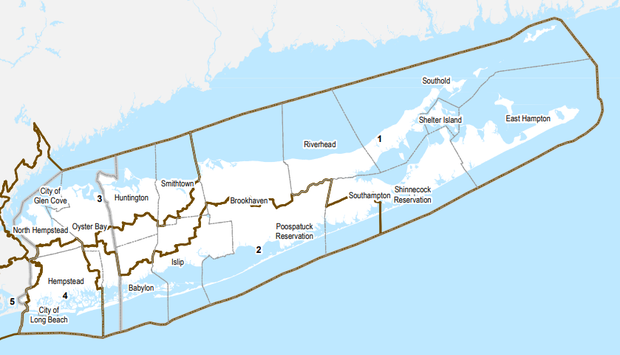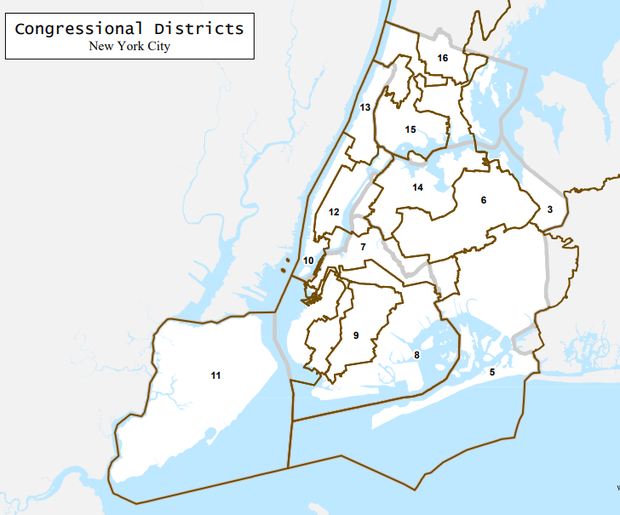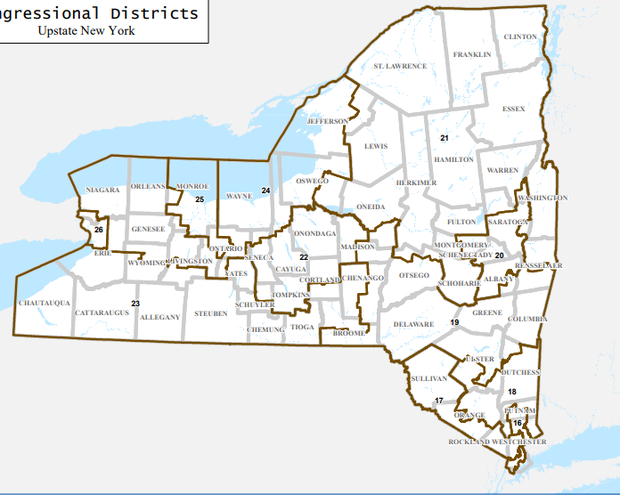Democratic lawmakers in New York passed a new congressional map Wednesday that could result in the loss of four seats for the Republican party — and create one of the most aggressive gerrymanders so far in the 2022 redistricting cycle.
The map awaits the final signature from Democratic Governor Kathy Hochul, who has expressed support for the legislature’s new map and who wants to “keep moving forward” ahead of the June primary.
The state is losing a congressional seat due to the 2020 Census data; New York fell just 89 residents short of holding onto all 27 of its districts.
In its current configuration, Democrats hold 19 congressional seats and Republicans hold eight. The newly-passed map would give Democrats a bigger advantage, with 22 seats to Republicans’ four.
New York Legislative Task Force
Republican Congressman Lee Zeldin’s Long Island seat in New York’s 1st District would become friendlier for Democrats by extending it along the North Shore further west in central Long Island and losing some of the redder areas — including where Zeldin lives. Zeldin is currently running for governor of New York.
GOP Congresswoman Nicole Malliotakis’ Staten Island district in New York’s 11th District would have more portions of Democrat-heavy Brooklyn drawn into it, creating a path to victory for its former Democratic Congressman, Max Rose, or perhaps former Mayor Bill de Blasio, a potential candidate for this seat since his home in Park Slope would be drawn into the district.
New York Legislative Task Force
“Democrats are trying to do a hail mary pass here in trying to change the rules, change the boundaries of the district, to try to tilt the scale and give the Democratic nominee an advantage to try and steal this seat,” Malliotakis said on New York radio on Wednesday, adding that she will still run for reelection.
In upstate New York, the new version of the 22nd District is drawn around the Democratic-leaning city of Syracuse. This will cause Republican Congresswoman Claudia Tenney, who currently represents the 22nd District, to move to the more Republican-friendly 23rd District in the western tip of the state, left open by retiring Republican Congressman Tom Reed.
Two of the more competitive seats that still lean Democratic are New York’s 19th, represented by Antonio Delgado, and the 18th District, represented by Democratic Congressional Campaign Committee Chair Sean Patrick Maloney.
“We’re living in the world where the maps were formed after decades of gerrymandering by Senate Republicans,” said Democratic State Senator and Deputy Majority Leader Michael Gianaris. “A lot of our work was just unraveling the bad political map drawing of the past.”
The task of redistricting fell to lawmakers in Albany after the state’s independent redistricting commission, a result of a 2014 constitutional amendment looking to reform the state’s redrawing process, failed to submit a consensus map in time.
Gianaris said while he respects the commissioners “who tried to make it work,” he called it a “flawed process born out of a political deal with the Republicans and former Governor Cuomo.” During his first term in 2012, former Governor Andrew Cuomo compromised on redistricting lines that benefitted both Republicans and Democrats, as well as establishing a panel to push for redistricting reforms.
New York Legislative Task Force
New York is a heavily Democratic state. President Biden won the state with 61% of the vote in 2020 and the state has voted for Democratic presidential candidates consistently since 1988.
“Everybody knows that New York is a deep blue state, and it shouldn’t be a surprise to anyone that the results of our redistricting may reflect that reality,” Gianaris said.
New York Republican party Chair Nick Langworthy told CBS New York the map “is the most brazen and outrageous attempt at rigging” an election, and threatened a lawsuit. Malliotakis said Thursday she also expects litigation over the maps.
But Jeff Wice, senior fellow for New York Law School’s Census and Redistricting Institute, said there’s not a strong case for litigation or an attempt to deem the map as invalid for the upcoming 2022 elections.
“The plan follows the state and federal requirements – this map has exact population deviation and respects minority voting rights. No New York State Court has rejected a state legislatively enacted redistricting plan in over 50 years, and the state courts in particular have deferred to judgments made by the Legislature,” said Wice.
The move from Democratic lawmakers to skew the map in favor of their party comes at a point in the redistricting cycle where neither party has a strong, clear advantage. Republicans have been trying to shore up their incumbents in states like Texas, take a seat away from Democrats in states like Georgia or pursue more aggressive gerrymanders that risk a court-ordered redraw like in Ohio or North Carolina.
Democratic lawmakers have been more aggressive in states where they hold control over the redrawing process, such as Maryland, Oregon or Illinois.
In late January, Maloney sent a memo to the independent commission outlining a more aggressive gerrymander for Democrats, pointing to the loss of population in the more Republican portions of the state.
While his party has decried Republican gerrymandering as an assault on voting rights, in recent days Maloney has been vocal about the party pushing its advantage when it can, since Republicans are favored to gain control of the House this November.
“If you’re asking us to unilaterally disarm — well I’m a guy that wants to bring a gun to a gun fight, you bet,” Maloney said on MSNBC this week.
Gianaris said Democrats aren’t “ignorant of what’s happening around the country and the national implications of our work.”
“But we have a long list of criteria that we are legally obligated to follow in New York. And so our priority was making sure we drew fair maps consistent with those standards,” he added.
“This plan is nowhere near in comparison to the plans Republicans have been enacting in Texas, Georgia and North Carolina. It’s a much more balanced plan,” argued Wice. “But in a competitive year, there are never any assurances on which party or candidate will win.”


